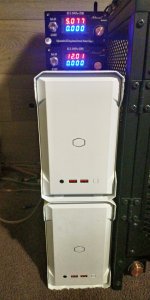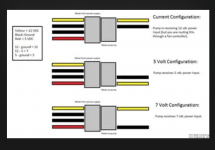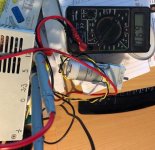I want to use two seperate linear power supplies to feed the 5v and 12v lines of the second power input of an ASUS STX II. (Four, actually)
For those who don't know, the STX II has a second molex power input for a cleaner power supply.
When looking up what colour wire is for the 12v and which is for the 5v I found that connecting both makes 7v.
Will using two different power supplies on the second input work? Or is there something special about PC power supplies that this solution needs and doesn't have?
Attached is the cases for the cards and the two power supplies.
For those who don't know, the STX II has a second molex power input for a cleaner power supply.
When looking up what colour wire is for the 12v and which is for the 5v I found that connecting both makes 7v.
Will using two different power supplies on the second input work? Or is there something special about PC power supplies that this solution needs and doesn't have?
Attached is the cases for the cards and the two power supplies.
Attachments
What do you mean 'connecting both,' both wires of any color to something else like a connector? Please sketch up a schematic, a connector diagram for the Asus card, and connector diagram or pic for the linear power supplies. The pic doesn't you attached doesn't show the details we would need in order to assist you.
I was literally about to connect the wires to the supplies when I saw this diagram image making me think twice about the nature of ATX power supplies, and how different they might be to what I was doing.What do you mean 'connecting both,'
I even saw somewhere that the STX II might not even make use of the 5v supply rails, but I can't find any documentation on that.
Attachments
Looks like you have two 5v linear power supplies.
Using an ATX power supply to produce 7v would be a bit risky since neither one of those two (12v, 5v) can ever be connected to the computer ground or it would make a dead short. Therefore, anything running from that kind of 7v power would have to be completely isolated from ground.
The 12v power could reasonably be used by STX II for analog circuitry such as opamps.
Using an ATX power supply to produce 7v would be a bit risky since neither one of those two (12v, 5v) can ever be connected to the computer ground or it would make a dead short. Therefore, anything running from that kind of 7v power would have to be completely isolated from ground.
The 12v power could reasonably be used by STX II for analog circuitry such as opamps.
That "7V" connection can't make real power. Draw out two AC/DC power supplies connected that way and look how the diodes run. If you have "verified" with a good voltmeter you are only reading stray leakage. Any useful load will drag it right down.
Ignorance is bliss.
Motor running from 7V connected ATX power supply.
That's a re-purposed ATX supply with banana sockets fitted in the side of the case.
Ground lifted as I wanted to be able to connect 2 supplies in series for split supply or >12V.
The ground must be connected to one of the terminals for a stable output voltage but it doesn't matter which.
Motor running from 7V connected ATX power supply.
That's a re-purposed ATX supply with banana sockets fitted in the side of the case.
Ground lifted as I wanted to be able to connect 2 supplies in series for split supply or >12V.
The ground must be connected to one of the terminals for a stable output voltage but it doesn't matter which.
Attachments
The linear vs switching debate is mostly hot air.
Don't know about hot air. its more about consumer audio verses high end audio, where for the latter case every little audible detail may matter to the end user. Doesn't take too much masking to obscure such small details anyway. If you don't hear a difference then it doesn't matter for you so don't worry.
I had an STX... it's 124dB using the computer power supply and the associated linear regulation/filtering under the shield.
There is ZERO reason to use linear power for it IMHO.
If you insist on using linear, You can make two supplies, one 5V using 7805 or something, the other 12V using a 7812 or something like it.
Connect both PSU grounds together on the black wires, connect 12V to yellow, connect 5V to red.
Seriously though, the ATX standard is cleaner than you think. My PSU can output 850W of 12V DC with less than 15mV of ripple, and the 5V line is even cleaner.


There is ZERO reason to use linear power for it IMHO.
If you insist on using linear, You can make two supplies, one 5V using 7805 or something, the other 12V using a 7812 or something like it.
Connect both PSU grounds together on the black wires, connect 12V to yellow, connect 5V to red.
Seriously though, the ATX standard is cleaner than you think. My PSU can output 850W of 12V DC with less than 15mV of ripple, and the 5V line is even cleaner.
Last edited:
Awesome replies guys, thankyou.
Markw4, it's a pair of 5-24v adjustable linear power supplies. As for whether I can hear the difference a linear power supply can bring, I'm interested to find out if I can 🙂
I asked ASUS, they escalated the inquiry and recommended using the one power supply on both ends (because of course they would)
It was probably a bit presumptuous of me to think that the various circuits would be isolated entirely from each other... But I'm glad I realised this before I flipped switches.
I was hoping someone who knew the STX II intricately would see the thread and say "hell yeah that would work, I even did it once and it sounded great"
My two options are:
1: buy an old PC from my friend, put an STX into it, wire it up to the supplies and keep a fire extinguisher handy.
Or
2: not do that.
Considering the money I've put into this, (incl a dozen Burson V6's) and kodabmx's good point about the considerable 124db SNR, (probably due to the cards linear regulator) I'll probably invest in an ATX standard LPSU at a later date.
Markw4, it's a pair of 5-24v adjustable linear power supplies. As for whether I can hear the difference a linear power supply can bring, I'm interested to find out if I can 🙂
I asked ASUS, they escalated the inquiry and recommended using the one power supply on both ends (because of course they would)
It was probably a bit presumptuous of me to think that the various circuits would be isolated entirely from each other... But I'm glad I realised this before I flipped switches.
I was hoping someone who knew the STX II intricately would see the thread and say "hell yeah that would work, I even did it once and it sounded great"
My two options are:
1: buy an old PC from my friend, put an STX into it, wire it up to the supplies and keep a fire extinguisher handy.
Or
2: not do that.
Considering the money I've put into this, (incl a dozen Burson V6's) and kodabmx's good point about the considerable 124db SNR, (probably due to the cards linear regulator) I'll probably invest in an ATX standard LPSU at a later date.
Why can't you just connect the other the linear power supply to 5V-0V (red-black in molex) and the other to 12V-0V (yellow-black in molex)?
Use one PS at 12V, and put a 7805 to get 5V from the 12V line, that is good for 1.5 A in some versions, enough for a sound card.
317 controlling 2955 / 3055 works too, many other types are available.
Provided of course the PS can provide sufficient current...
No need then for a second PS...
317 controlling 2955 / 3055 works too, many other types are available.
Provided of course the PS can provide sufficient current...
No need then for a second PS...
That's what this thread is about.Why can't you just connect the other the linear power supply to 5V-0V (red-black in molex) and the other to 12V-0V (yellow-black in molex)?
- Home
- Design & Build
- Construction Tips
- Two power supplies to a molex



